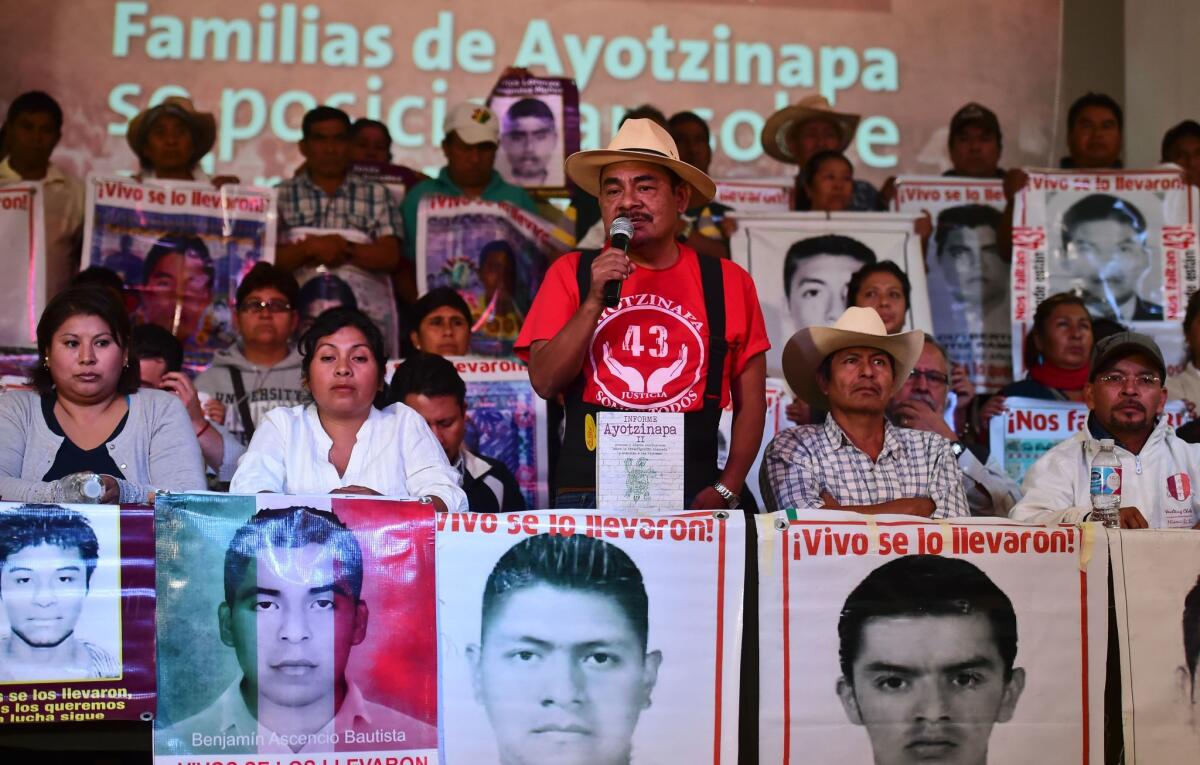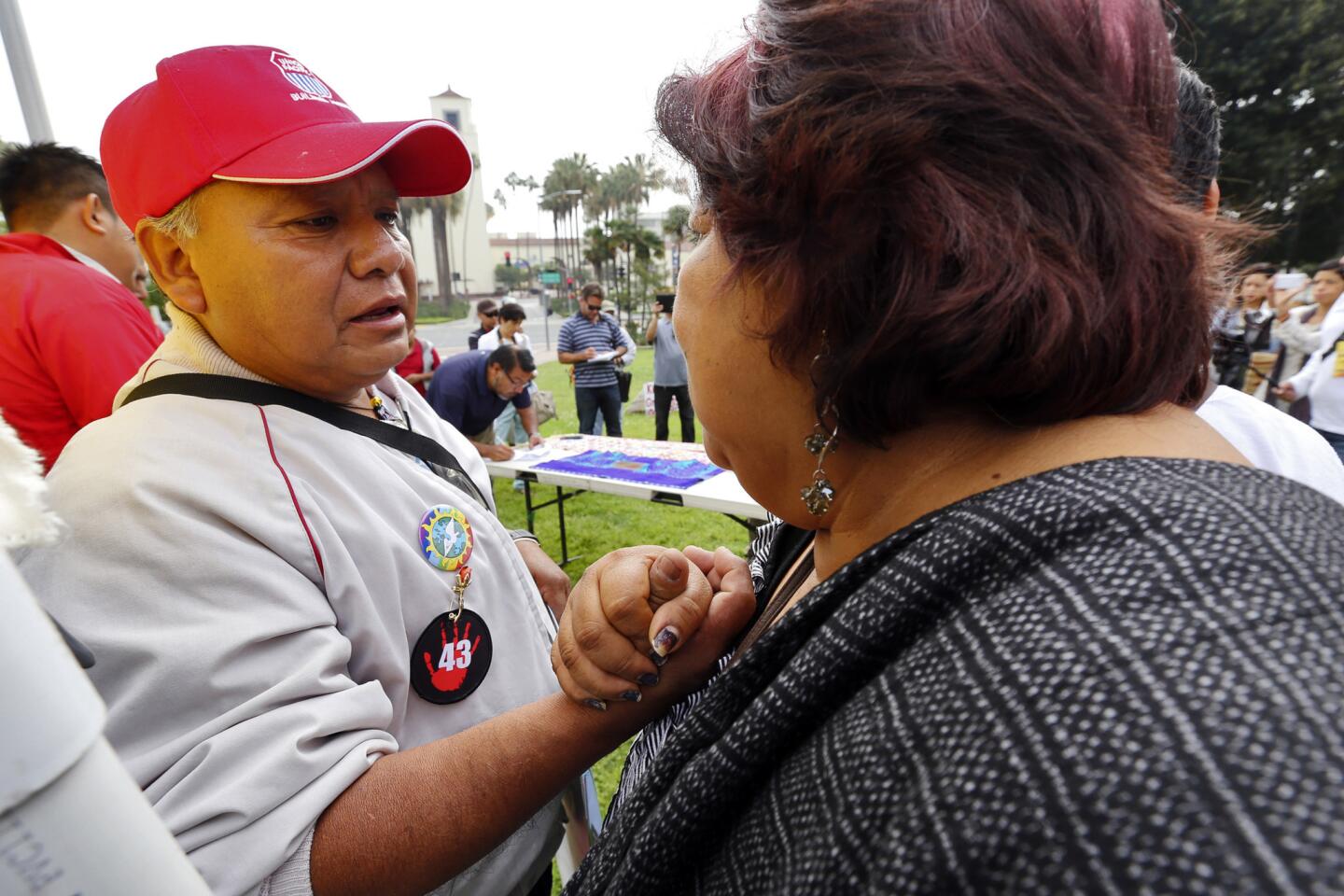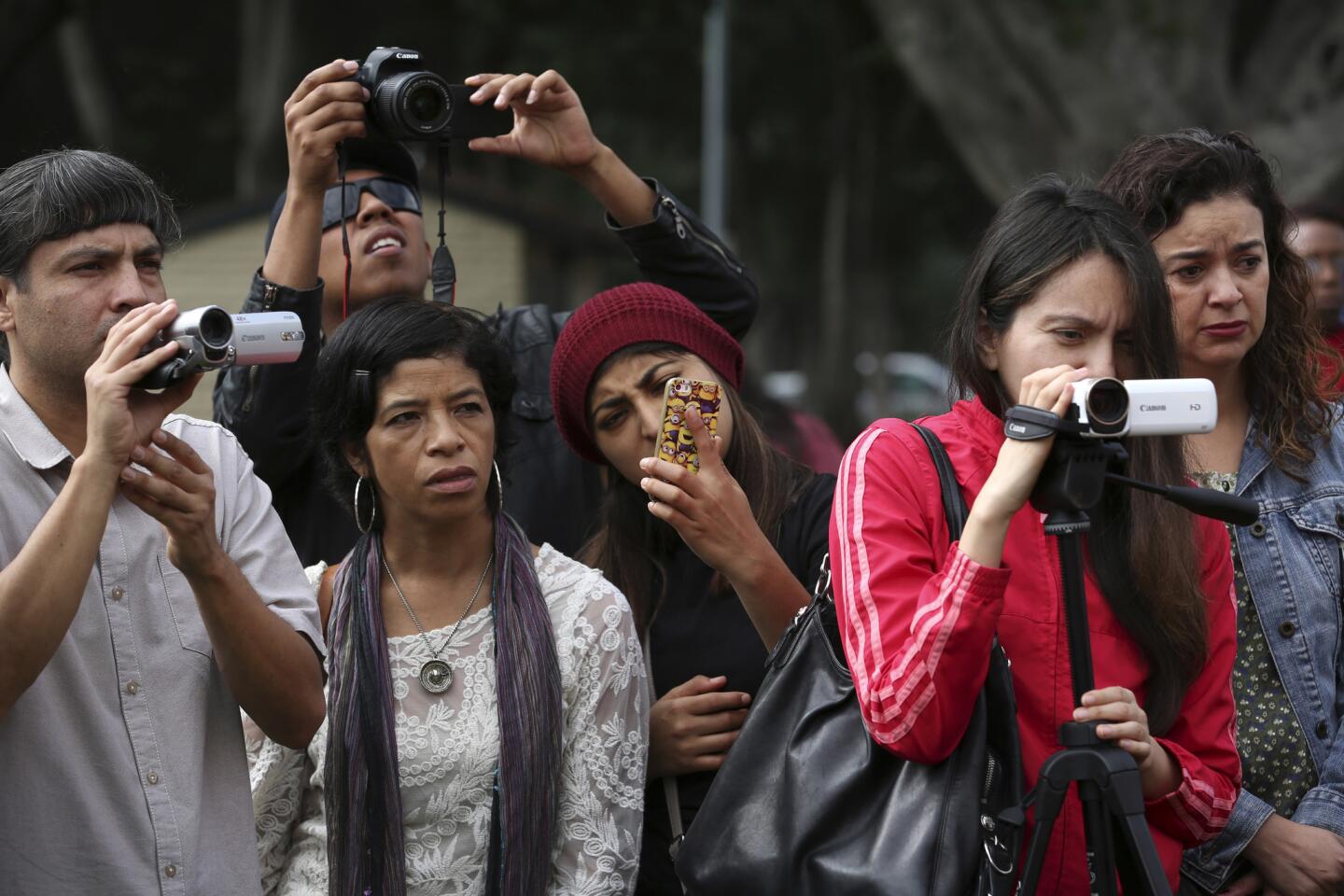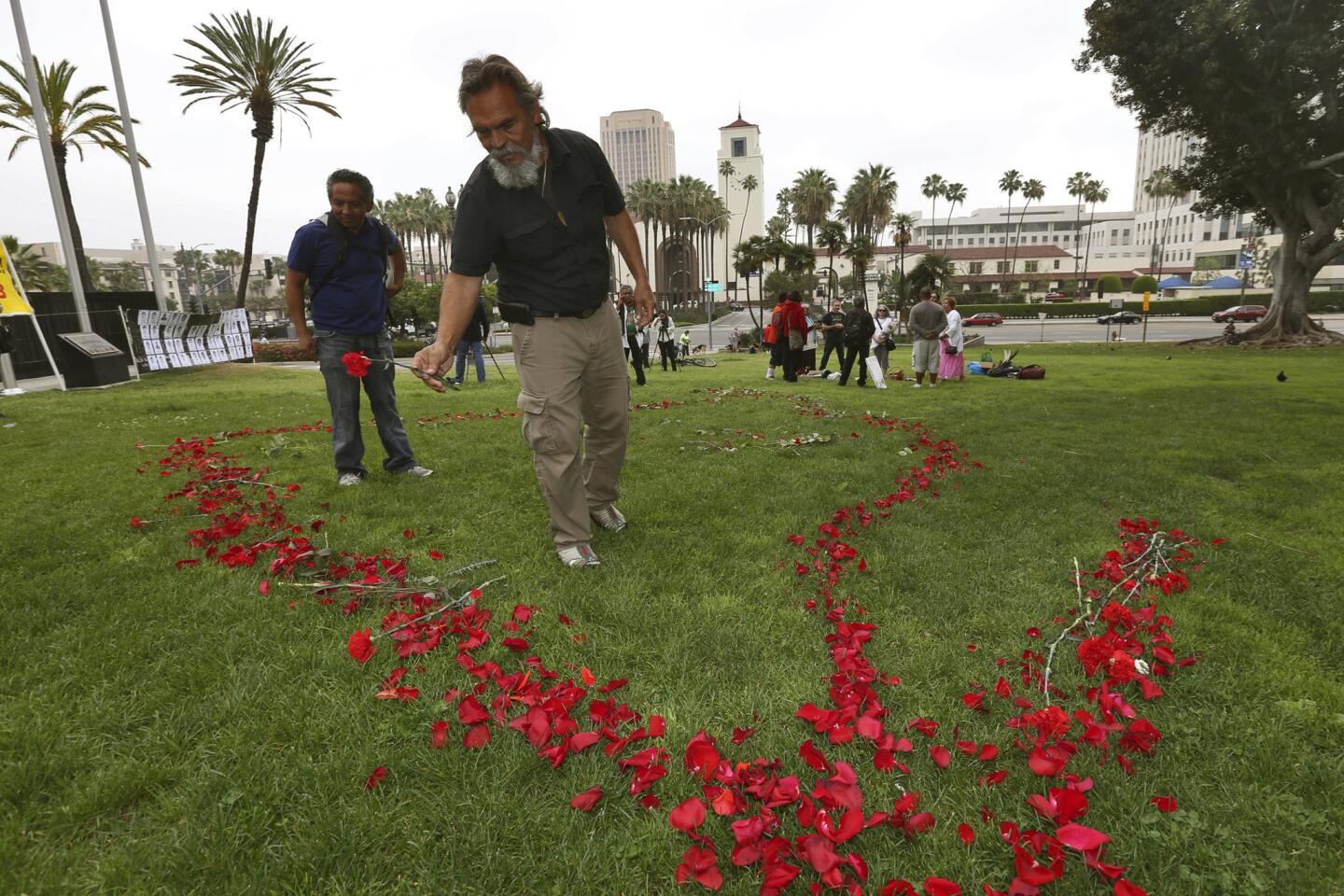New report raises chilling possibility that mystery of 43 Mexican students’ disappearance will never be solved
In hundreds of riveting, scathing pages, a panel of international experts has recounted the chaos and horrors that engulfed 43 Mexican college students on a rainy night in September 2014.
The damning compilation of events in the panel’s 605-page report, issued Sunday, shattered the official account given by the government of what happened — yet failed to answer the most pressing questions: Where are the 43 young men? How did their lives, presumably, end? And how high in the government should blame go?
The government, members of the investigative group said, put up roadblocks on the path to answering those questions, raising the chilling possibility that the mystery of the students’ disappearance will never be solved.
Much of what happened that night had already been widely reported.
From their small, rural college in Ayotzinapa, in mountainous Guerrero state just south of Mexico City, the students had gone on a spree of commandeering buses in the city of Iguala in hopes of reaching a demonstration, much as they had done many times before.

Felipe de la Cruz, father of one of 43 missing college students, speaks during a news conference in Mexico City on Monday.
Instead, they were intercepted by police who set up roadblocks and opened fire repeatedly on buses and other vehicles trying to escape. Six people were killed immediately, including a high school soccer player and a woman in a taxi; the wounded desperately sought aid in local clinics but were turned away. Finally, police rounded up the 43 students they could catch and took them away, never to be seen again.
The body of another student that went missing in the melee was so badly mutilated — it appeared the face had been skinned — that it could not be immediately identified.
“We would have liked to bring news of the whereabouts” of the 43 students, said panel member Carlos Beristain, a Spanish doctor who specializes in conflict trauma. “The investigation remains open.”
Claudia Paz, another panelist and former attorney general in Guatemala, said that, despite the work, “we are unable to respond to the question that we asked ourselves every night for the last year and a month and that all of the fathers and mothers” continue to ask.
The Mexican government, which invited the investigation, has given the appearance of seeking to whitewash events, evade responsibility and sabotage an effort at finding the truth. But at what cost?
Its credibility and any reputation for protecting human rights and for fostering justice has been badly damaged. President Enrique Peña Nieto, already suffering low approval ratings at home, is a crippled leader with 2 1/2 years left in his administration — and two months ahead of critical regional elections. His inability to enact economic and judicial reforms that once awakened so much promise is of growing concern in Washington.
Before the international investigators began their work in March of last year, the government had put forward what it called the “historical truth” in the Ayotzinapa case based on its own investigation: The students were taken away by local police on the orders of the mayor of Iguala and handed over to a drug-trafficking gang, which killed them and incinerated their bodies in a nearby trash dump.
But the panel, made up of five lawyers and human rights experts from Latin America and Spain and appointed by the Inter-American Human Rights Commission, determined the official investigation was riddled with inconsistencies and flaws. The commission is an autonomous arm of the Organization of American States, and was initially invited by the Mexican government to hold the inquiry.
It found that the government’s version of events was based largely on testimony acquired by torturing suspects. At least 17 suspects, out of more than 170 people arrested, were tortured or subjected to “cruel and inhumane” treatment, the panel said in its report.
The panel established in the most concrete form to date that federal police and military stationed nearby were aware of what was happening that night and may have participated or directly observed. That would fly in the face of government assertions that all official involvement was at a local level.
Forensic evidence indicated that no fire took place in the trash dump capable of incinerating 43 bodies, the investigators said. And a video the team acquired appeared to show personnel from the Mexican attorney general’s office planting remains in a river a day before they were recovered. (Those remains purportedly contained the only bone fragment that has been identified as belonging to one of the students.)
The report also advanced one possible theory for the attack on the students: The buses were being used to traffic heroin to the U.S.
The panel said its work was repeatedly blocked by bureaucratic hurdles and government resistance. Members said they were never granted requests to interview military personnel in the zone that night and were also denied access to a number of documents and witnesses.
In responding to the report, Peña Nieto thanked the panel, known as the Interdisciplinary Group of Independent Experts, or GIEI, its acronym in Spanish, and said authorities would “analyze” the report and its recommendations.
Eber Betanzos, Mexico’s deputy attorney general, insisted that his office met 85% of the panel’s requests and was working on the final ones.
The GIEI investigators also denounced a smear campaign against their work and against human rights activists in Mexico that many believe was orchestrated by the government hoping to quiet criticism. Pro-government newspapers and broadcasters accused the investigators of spending money wildly and of being determined to insult national institutions like the army.
On Sunday, when the report was presented, no member of the federal government attended the ceremony. On Monday, most newspapers carried modest front-page stories, but without headlines mentioning torture.
When it became clear that the findings were going to be critical, “the government attempted what seems to be an increasingly common pattern: desprestigiar — kill the messenger,” said Tony Payan, an expert on Mexico at Rice University’s Baker Institute for Public Policy. The investigation “has only created more confusion. And that may be what the government wants.”
The report released Sunday was the second of two. There won’t be a third; the Peña Nieto government declined to renew permission for the panel to continue its work.
Concern is growing in the U.S. government that Peña Nieto is spending too much of his political capital in putting out fires and attempting to silence his critics. The U.S. has invested millions of dollars in Mexico’s efforts to revamp its police agencies and judicial system; tragedies like the Ayotzinapa case only expose the depth with which corruption and impunity continue to rot those systems from the inside out.
In a statement, the Obama administration pointedly praised the work of the panel, then added:
“We trust the Mexican authorities will carefully consider the report’s recommendations, evaluate suggested actions to address the issue of forced disappearances, provide support to the victims’ families, and continue their efforts to bring the perpetrators of this terrible crime to justice.”
The Ayotzinapa scandal has roiled Mexico like few others, triggering massive protests in Mexico and abroad. Part of the pathos is that the students were studying to become teachers at a school set up for the impoverished children of peasants.
The handling of the case will further antagonize the Mexican government’s already testy relationship with human rights organizations, some international bodies like the United Nations’ special rapporteur on torture, and a number of U.S. Congress members and senators.
Yet it does not seem likely the administration will put much public pressure to bear on the Peña Nieto government. For one, Washington needs Mexican cooperation on a host of other pressing issues, such as immigration, commerce and drug-trafficking. And U.S. officials are painfully aware of Mexico’s propensity to become defensive when challenged.
The handling of the panel’s investigation is indicative of that, said Eric Olson of the Wilson Center’s Mexico Institute. “There is initial goodwill and interest in showing transparency,” he said, “but when it gets to the details, there is a very strong reaction that resists outside scrutiny.”
Special correspondent Cecilia Sanchez in Mexico City contributed to this report.
Follow @TracyKWilkinson on Twitter
ALSO
Meet the Catholic grocer who helps Mexican Jews keep kosher
Raised in the U.S. without legal status, he attains the American dream — in Mexico
Murder of acclaimed activist has U.S. questioning massive Central American aid package
More to Read
Start your day right
Sign up for Essential California for news, features and recommendations from the L.A. Times and beyond in your inbox six days a week.
You may occasionally receive promotional content from the Los Angeles Times.












